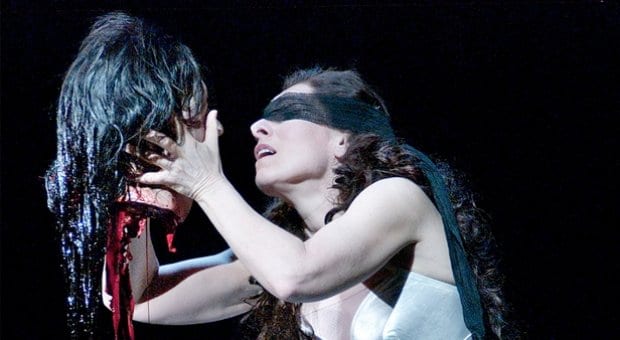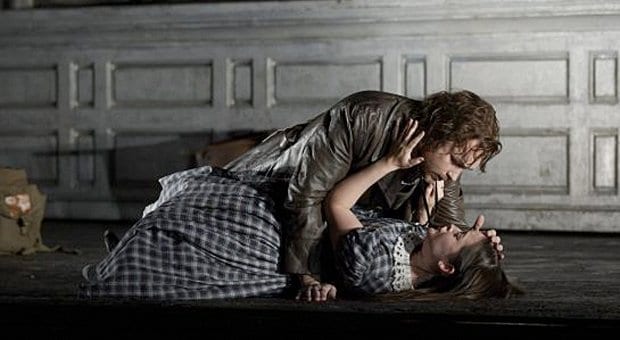
Helen Field as Salome in the Canadian Opera Company's 2002 production of Salome. Credit: Michael Cooper
Arias, overtures and parlando. Yes, opera can be intimidating for a novice.
But what better reason to learn?
The Canadian Opera Company’s spring season is underway and runs until the end of May. Xtra‘s opera maven Lydia Perovic previews two of the company’s three spring shows, even providing a few tips for those readers looking to impress a date.
Lucia di Lammermoor (1835)
By Gaetano Donizetti
Libretto by Salvadore Cammarano based on Walter Scott’s novel The Bride of Lammermoor
Directed at the COC by David Alden
What happens? Lucia is in love with her brother’s worst enemy. They try a long-distance relationship, but their letters are intercepted, and besides, the only way the Lammermoor family misfortunes can be reversed is if Lucia marries the man of her brother’s choosing. The wedding is set up, but big surprises await. There will be blood. Litres and litres . . . The Carrie amount.
How much is the soprano tortured? Four out of five whips. The soprano actually kills somebody here, for a change, but the total-disintegration mad scene is a classic, and her other big aria, the early “Regnava nell silenzio,” contains indications of the bizarre state of her mind. It also happens to recount her encounter with the ghost of a murdered woman.
How much male homosociality? Lots. The entire plot is carried by a small group of men, behaving incongruously and sentimentally. Lucia’s brother, Enrico, and her lover, Edgardo, are entangled by multiple ties of hatred and obsession.
What to look for in the music? The sextet in Act 2, “Chi mi frena,” is spectacular. (It starts with Edgardo bursting in.) In Act 3, Lucia’s mad scene opens with a warped take on the earlier “Regnava il silenzio,” this time played on a glass harmonica. The melody of her Act 1 matrimonial duet with Edgardo also sneaks in to the mad scene. Otherwise, follow the soprano on the wild ride here. If you like a grieving tenor, Edgardo’s farewell is the thing you will like – a tenor mad scene in its own right.
What kind of a date to invite? There is zero erotic tension in this opera, and it will work fine as a respite from flirting. Age-wise, the young, under-30 crowd will be at home here, but also people over 60. Poetry lovers. Non-ironic people. People intrigued by Victoriana. True Blood fans and people into vampires. John Hughes fans. Those who like coming-of-age stories.
Conversation starter at the intermission: My first Lucia was actually the blue alien in The Fifth Element. Remember that film?
Salome (1905)
By Richard Strauss
Oscar Wilde’s play Salome translated into German by Hedwig Lachmann
Directed at the COC by Atom Egoyan
What happens? Herodes, the ruler of the Roman province Judea, has a thing for his young step-daughter Salome. She, on the other hand, has a thing for the imprisoned prophet, who happens to be John the Baptist. Herodes asks Salome to dance for him, which she agrees to do under one condition: John’s head on the platter, so she can finally kiss him.
How much is the soprano tortured? Two out of five whips, and both earned in the final brutal scene of Salome’s punishment.
Homosociality: A particularly low point for female solidarity, the mother-daughter relationship in Salome is marked by calculation and indifference. Early on, there’s a short-lived storyline involving the Page who has yen for Narraboth, the captain of the guard. The carriers of action, both dramatic and theological, are again mainly on the male side.
What to look for in the music? Note how Strauss gives different musical material to Jochanaan (St John the Baptist) and Salome in order to sculpt out a different personality for each. A menacing chilly wind appears from the orchestra at two dramatic points. Murder of Jochanaan is not shown, but rendered through orchestral score, with timpani and double bass used very expressively. After the prophet’s head is offered, the opera culminates in Salome’s dramatic final monologue, which contains many of the musical motifs heard earlier.
What kind of a date to bring? The person you desire. An Oscar Wilde completist. A psychoanalyst, so you can pick their brain (“That Lacanian quip, ‘There is no sexual relationship,’ . . . this is exactly that, right?”). A friend in a dry spell, so he/she can feel better about not being in lust.
Intermission chatter: “My favourite Egoyan film is actually the little known Felicia’s Journey. His mastery is in evidence much more there than in any other film he made before or since.”

 Why you can trust Xtra
Why you can trust Xtra


